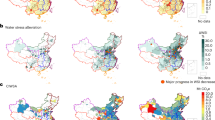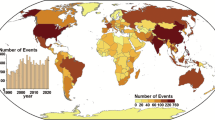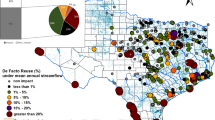Abstract
Municipal water managers are intensifying efforts to reduce urban water use and increase the reliability of local water supplies to combat rising water scarcity and drought. Incentivizing increases in water-use efficiency and mandating conservation are two strategies to rein in demand. Concurrently, local water supplies are being augmented through investments in reclaiming and treating municipal wastewater. Although reducing urban water consumption is necessary to deal with population growth and a more variable climate, it does come at a cost. In particular, cutting back on indoor water consumption impacts the generation and quality of wastewater, which can have widespread and underappreciated consequences on human society and the environment. Here, to quantify these impacts, we tracked monthly effluent flow, salinity levels and the properties of 34 wastewater treatment plants throughout Southern California from 2013 to 2017—a period that included extreme drought and abundant precipitation. Our analysis demonstrates that conservation measures significantly reduced effluent flow and increased effluent salinity (P value ≤ 0.05). Our findings further highlight the need for policymakers to recognize the interdependencies and complexities within a water system.
This is a preview of subscription content, access via your institution
Access options
Access Nature and 54 other Nature Portfolio journals
Get Nature+, our best-value online-access subscription
$29.99 / 30 days
cancel any time
Subscribe to this journal
Receive 12 digital issues and online access to articles
$119.00 per year
only $9.92 per issue
Buy this article
- Purchase on Springer Link
- Instant access to full article PDF
Prices may be subject to local taxes which are calculated during checkout





Similar content being viewed by others
Data availability
All data that support the findings of this study are available from the corresponding authors on request.
References
Schwabe, K., Albiac, J., Connor, J. D., Hassan, R. M. & González, L. M. Drought in Arid and Semi-Arid Regions: A Multi-Disciplinary and Cross-Country Perspective (Springer, 2013).
Berbel, J. & Esteban, E. Droughts as a catalyst for water policy change. Analysis of Spain, Australia (MDB), and California. Glob. Environ. Change 58, 101969 (2019).
Trindade, B., Reed, P. & Characklis, G. Deeply uncertain pathways: integrated multi-city regional water supply infrastructure investment and portfolio management. Adv. Water Resour. 134, 103442 (2019).
Olmstead, S. M. The economics of managing scarce water resources. Rev. Environ. Econ. Policy 4, 179–198 (2010).
Olmstead, S. M. & Stavins, R. N. Comparing price and nonprice approaches to urban water conservation. Water Resour. Res. 45, W04301 (2009).
Gilligan, J. M. et al. Urban water conservation policies in the United States. Earth’s Future 6, 955–967 (2018).
Nemati, M., Buck, S. & Soldati, H. The effect of social and consumption analytics on residential water demand. In The Association of Environmental and Resource Economists (AERE) Session, American Economic Association Annual Meeting 1–47 (SSRN, 2016); http://dx.doi.org/10.2139/ssrn.2877233
Nemati, M. & Penn, J. The impact of social norms, feedback, and price information on conservation behavior: a meta-analysis. In Agricultural and Applied Economics Association Annual Meeting 1–24 (Agricultural and Applied Economics Association, 2018); https://doi.org/10.22004/ag.econ.274431
Brent, D. A., Cook, J. H. & Olsen, S. Social comparisons, household water use, and participation in utility conservation programs: evidence from three randomized trials. J. Assoc. Environ. Resour. Econ. 2, 597–627 (2015).
Baerenklau, K. A., Schwabe, K. A. & Dinar, A. The residential water demand effect of increasing block rate water budgets. Land Econ. 90, 683–699 (2014).
Schwabe, K. A., Baerenklau, K. A. & Dinar, A. Coping with water scarcity: the effectiveness of allocation-based pricing and conservation rebate programs in California’s urban sector. Policy Matters 6, 1–7 (2014).
Grafton, R. Q., Chu, L. & Wyrwoll, P. The paradox of water pricing: dichotomies, dilemmas, and decisions. Oxf. Rev. Econ. Policy 36, 86–107 (2020).
Hanak, E. et al. California’s Water: Water for Cities (Public Policy Institute of California, 2018).
Tran, Q. K., Jassby, D. & Schwabe, K. A. The implications of drought and water conservation on the reuse of municipal wastewater: recognizing impacts and identifying mitigation possibilities. Water Res. 124, 472–481 (2017).
Municipal Wastewater Recycling Survey (State Water Resources Control Board, 2017); https://go.nature.com/35aqnL1
Stokes, J. R. & Horvath, A. Energy and air emission effects of water supply. Environ. Sci. Technol. 43, 2680–2687 (2009).
Chappelle, C., Jassby, D., McCann, H., Schwabe, K. & Szeptycki, L. Managing Wastewater in a Changing Climate (Public Policy Institute of California, 2019).
Grant, S. B. et al. Taking the “waste” out of “wastewater” for human water security and ecosystem sustainability. Science 337, 681–686 (2012).
Grafton, R. et al. The paradox of irrigation efficiency. Science 361, 748–750 (2018).
Dumont, A., Mayor, B. & López-Gunn, E. Is the rebound effect or Jevons paradox a useful concept for better management of water resources? Insights from the irrigation modernisation process in Spain. Aquat. Pr. 1, 64–76 (2013).
Alcott, B. Jevons’ paradox. Ecol. Econ. 54, 9–21 (2005).
Di Baldassarre, G. et al. Water shortages worsened by reservoir effects. Nat. Sustain. 1, 617–622 (2018).
Gohari, A. et al. Water transfer as a solution to water shortage: a fix that can backfire. J. Hydrol. 491, 23–39 (2013).
Kallis, G. Coevolution in water resource development: the vicious cycle of water supply and demand in athens, greece. Ecol. Econ. 69, 796–809 (2010).
Scott, C. A., Vicuña, S., Blanco Gutiérrez, I., Meza, F. & Varela Ortega, C. Irrigation efficiency and water-policy implications for river-basin resilience. Hydrol. Earth Syst. Sci. 18, 1339–1348 (2014).
Making Water Conservation a California Way of Life (California Department of Water Resources & State Water Resources Control Board, 2018); https://water.ca.gov/LegacyFiles/wateruseefficiency/conservation/docs/20170407_EO_B-37-16_Final_Report.pdf
Mann, M. E. & Gleick, P. H. Climate change and California drought in the 21st century. Proc. Natl Acad. Sci. USA 112, 3858–3859 (2015).
Shukla, S., Safeeq, M., AghaKouchak, A., Guan, K. & Funk, C. Temperature impacts on the water year 2014 drought in California. Geophys. Res. Lett. 42, 4384–4393 (2015).
Mount, J. & Hanak, E. Water Use in California (Public Policy Institute of California, 2014).
Schwabe, K., Nemati, M., Landry, C. & Zimmerman, G. Water markets in the western United States: trends and opportunities. Water 12, 233 (2020).
Buck, S., Nemati, M. & Sunding, D. L. The welfare consequences of the 2015 California drought mandate: evidence from new results on monthly water demand. In Agricultural and Applied Economics Association Annual Meeting 1–38 (Agricultural and Applied Economics Association, 2016); https://doi.org/10.22004/ag.econ.236049
Nemati, M., Buck, S. & Sunding, D. Cost of California’s 2015 drought water conservation mandate. ARE Update 21, 9–11 (2018).
Proposition 1 Bond Accountability (California Natural Resources Agency, 2019); http://bondaccountability.resources.ca.gov/p1.aspx
Tran, Q. K., Schwabe, K. A. & Jassby, D. Wastewater reuse for agriculture: development of a regional water reuse decision-support model (RWRM) for cost-effective irrigation sources. Environ. Sci. Technol. 50, 9390–9399 (2016).
Bertrand, M., Duflo, E. & Mullainathan, S. How much should we trust differences-in-differences estimates? Q. J. Econ. 119, 249–275 (2004).
Halvorsen, R. & Palmquist, R. The interpretation of dummy variables in semilogarithmic equations. Am. Econ. Rev. 70, 474–475 (1980).
Cameron, A. C. & Trivedi, P. K. Microeconometrics: Methods and Applications (Cambridge Univ. Press, 2005).
Wooldridge, J. M. Econometric Analysis of Cross Section and Panel Data (MIT Press, 2010).
Angrist, J. D. & Pischke, J.-S. Mostly Harmless Econometrics: An Empiricist’s Companion (Princeton Univ. Press, 2008).
Acknowledgements
We thank S. Wasif for the preparation of Fig. 1; and S. Erysian from the California Department of Water Resources, C. Nagai and B. Coffey from the Metropolitan Water District, and C. Berch from Jurupa Community Services District for data guidance and input.
Author information
Authors and Affiliations
Contributions
K.S., M.N. and D.J. designed research. K.S., M.N., R.A. and Q.T. performed research. K.S., M.N., R.A., Q.T. and D.J. wrote the paper.
Corresponding author
Ethics declarations
Competing interests
The authors declare no competing interests.
Additional information
Publisher’s note Springer Nature remains neutral with regard to jurisdictional claims in published maps and institutional affiliations.
Supplementary information
Supplementary Information
Supplementary Tables 1–6.
Rights and permissions
About this article
Cite this article
Schwabe, K., Nemati, M., Amin, R. et al. Unintended consequences of water conservation on the use of treated municipal wastewater. Nat Sustain 3, 628–635 (2020). https://doi.org/10.1038/s41893-020-0529-2
Received:
Accepted:
Published:
Issue Date:
DOI: https://doi.org/10.1038/s41893-020-0529-2
This article is cited by
-
Addressing the contribution of indirect potable reuse to inland freshwater salinization
Nature Sustainability (2021)



